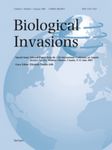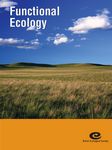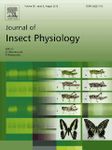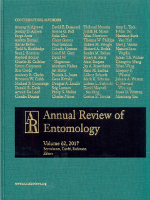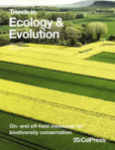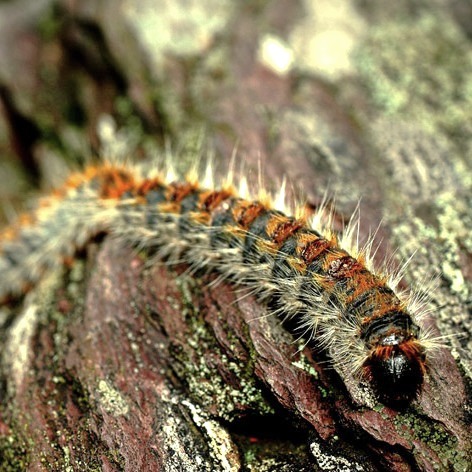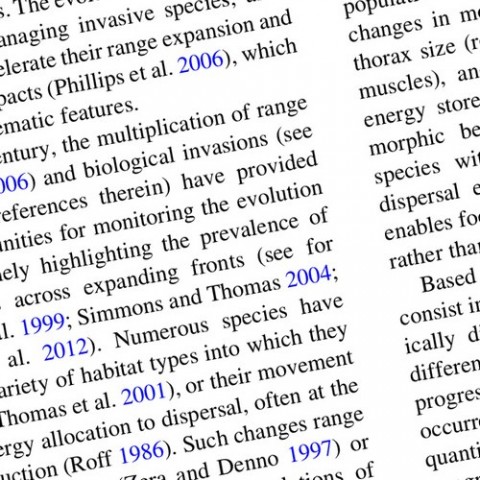Publications in peer-reviewed journals and book chapters
28. Intra- and interspecific variations in flight performance of oak forest Agrilinae (Coleoptera: Buprestidae) using computerised flight mills.
Le Souchu E, Sallé A, Bankhead-Dronnet S, Laparie M* & Sauvard D* (*: equal contributions). Peer Community Journal, https://peercommunityjournal.org/articles/10.24072/pcjournal.560, 2025
27. Seasonality of forest insects: why diapause matters
Schebeck M., Lehmann P., Laparie M., Bentz B. J., Ragland G. J., Battisti A. & Hahn D. A.
Trends in Ecology and Evolution, 39, 8P757-770, doi: https://doi.org/10.1016/j.tree.2024.04.010, 2024
26. A retrospective analysis on the effects of climate warming on the pine processionary moth at the southern edge of its range
Bourougaaoui A., Robinet C., Ben Jamâa M. L. & Laparie M.
Oikos, e10989, doi: https://doi.org/10.1111/oik.10989, 2024
25. Effects of climate warming on the pine processionary moth at the southern edge of its range: a retrospective analysis on egg survival in Tunisia
Bourougaaoui A., Robinet C., Ben Jamâa M. L. & Laparie M.
bioRxiv 2021.08.17.456665, peer-reviewed and recommended by Peer Community In Ecology (https://doi.org/10.24072/pci.ecology.100097), doi: https://doi.org/10.1101/2021.08.17.456665, 2022
24. Warming causes atypical phenology in a univoltine moth with differentially sensitive larval stages
Poitou L., Laparie M., Pincebourde S., Rousselet J., Suppo C., & Robinet C.
Frontiers in Ecology and Evolution, https://doi.org/10.3389/fevo.2022.825875, 2022
23. When insect pests build their own thermal niche: the hot nest of the pine processionary moth
Poitou L., Robinet C., Suppo C., Rousselet J., Laparie M. & Pincebourde S.
Journal of Thermal Biology, 98, https://doi.org/10.1016/j.jtherbio.2021.102947, 2021
22. Diapause regulation in newly invaded environments: termination timing allows matching novel climatic constraints in the Box Tree Moth, Cydalima perspectalis (Lepidoptera: Crambidae)
Poitou L., Bras A., Pineau P., Lorme P., Roques A., Rousselet J., Auger-Rozenberg M.-A. & Laparie M.
Insects, 11, 620, https://doi.org/10.3390/insects11090629, 2020
21. Comparative studies of egg parasitoids of the pine processionary moth (Thaumetopoea pityocampa, Den. & Schiff.) in historic and expansion areas in France and Bulgaria
Georgiev G., Rousselet J., Laparie M., Robinet C., Georgieva M., Zaemdzhikova G., Roques A., Bernard A., Poitou L., Buradino M., Kerdelhué C., Rossi J.-P., Matova M., Boyadzhiev P. & Mirchev P.
Forestry: An International Journal of Forest Research, cpaa022, https://doi.org/10.1093/forestry/cpaa022, 2020
20. Winter temperature predicts prolonged diapause in pine processionary moth across its geographic range
Merel C., Bonsignore P., El Fels M.A.E.A., Giomi F., Hódar J., Laparie M., Marini L., Salman M.H.R., Zalucki M.P., Zamoum M. & Battisti A.
PeerJ e6530, 2019
19. Termination of pupal diapause in the pine processionary moth (Thaumetopoea pityocampa)
Salman M.H.R., Giomi F., Laparie M., Lehmann P., Pitacco A. & Battisti A.
Physiological Entomology 44, 53–49, 2019
18. Prepupal diapause synchronizes adult emergence in the pine processionary moth Thaumetopoea pityocampa (Lepidoptera: Notodontidae)
Salman M.H.R., Giomi F., Laparie M., Lehmann P. & Battisti A.
Agricultural and Forest Entomology 20, 582-588, 2018
17. Environmental adaptations, ecological filtering, and dispersal central to insect invasions
Renault D., Laparie M., McCauley S.J. & Bonte D.
Annual Review of Entomology 63, 345–368, DOI 10.1146/annurev-ento-020117-043315, 2018
16. Respiration-based monitoring of metabolic rate following cold-exposure in two invasive Anoplophora species depending on acclimation regime
Javal M., Roques A., Roux G. & Laparie M.
Comparative Biochemistry and Physiology Part A 216, 20–27, 2018
15. New insights into the ecology of Merizodus soledadinus, a predatory carabid beetle invading the sub-Antarctic Kerguelen Islands
Ouisse T., Laparie M., Lebouvier M. & Renault D.
Polar Biology, DOI 10.1007/s00300-017-2134-z, 2017
14. Wing morphology of the active flyer Calliphora vicina (Diptera, Calliphoridae) during its invasion of the Kerguelen Islands, a sub-Antarctic archipelago where insect flightlessness is the rule
Laparie M., Vernon P., Cozic Y., Frenot Y., Renault D. & Debat V.
Biological Journal of the Linnean Society 119, 179–193, DOI 10.1111/bij.12815, 2016
13. Physiological responses to temperature in Merizodus soledadinus (Col., Carabidae), a subpolar carabid beetle invading sub-Antarctic islands
Laparie M. & Renault D.
Polar Biology 39, 35–45, 2016
12. Comparative salinity tolerance in native flies from the subantarctic Kerguelen islands: a metabolomic approach
Renault D., Lombard M., Vingère J. & Laparie M.
Polar Biology 39, 47–56, 2016
11. Looking beyond the large scale effects of global change: local phenologies can result in critical heterogeneity in the pine processionary moth
Robinet C., Laparie M. & Rousselet J.
Frontiers in Physiology 6, 334, DOI 10.3389/fphys.2015.00334, 2015
10. Characterization of the habitats colonized by the alien ground beetle Merizodus soledadinus at the Kerguelen Islands
Renault D., Chevrier M., Laparie M., Vernon P. & Lebouvier M.
Revue d’Écologie (Terre et Vie), Supp. 12 « Espèces invasives », 28–32, 2015
9. What are the drivers of the pine processionary moth’s expansion?
Laparie M. & Roques A.
In Roques A. (Ed.), Processionary moths and climate change, Springer Quae, France, pp. 85–92, 2014
8. Is dispersal promoted during range expansion of invasive species? Morphological analysis of a ground beetle invading the Kerguelen Islands, Merizodus soledadinus (Coleoptera, Carabidae)
Laparie M., Renault D., Lebouvier M. & Delattre T.
Biological Invasions 15, 1641–1648, 2013
7. Metabolic fingerprinting of the responses to salinity in the invasive ground beetle Merizodus soledadinus at the Kerguelen Islands
Hidalgo K., Laparie M., Bical R., Larvor V., Bouchereau A., Siaussat D. & Renault D.
Journal of Insect Physiology 59, 91–100, 2012
6. Heat shock protein responses to salinity, food deprivation, and temperature in the invasive ground beetle Merizodus soledadinus at the Kerguelen Islands
Siaussat D., Laparie M., Maria A. & Renault D.
Polar Biology 36, 201–209, 2012
5. Habitat phenotyping of two sub-Antarctic flies by metabolic fingerprinting: evidence for a species outside its home?
Laparie M., Bical R., Larvor V., Vernon P., Frenot Y. & Renault D.
Comparative Biochemistry and Physiology Part A 162, 406–412, 2012
4. Exploring the plastic response to cold acclimation in Drosophila melanogaster through metabolomics
Colinet H., Larvor V., Laparie M. & Renault D.
Functional Ecology 26, 711–722, 2012
3. Starvation resistance and energetic consequences of prey choice in a predatory insect invading the Kerguelen Islands, the ground beetle Merizodus soledadinus
Laparie M., Larvor V., Frenot Y. & Renault D.
Comparative Biochemistry and Physiology Part A 161, 122–129, 2012
2. The significance of the sub-Antarctic Kerguelen Islands for the assessment of the vulnerability of native communities to climate change, alien insect invasions and plant viruses
Lebouvier M., Laparie M., Hullé M., Marais A., Cozic Y., Lalouette L., Vernon P., Candresse T., Frenot Y. & Renault D.
Biological Invasions 13, 1195–1208, 2011
1. Variation of morphometric traits in populations of an invasive carabid predator (Merizodus soledadinus) within a sub-Antarctic island
Laparie M., Lebouvier M., Lalouette L. & Renault D.
Biological Invasions 12, 3405–3417, 2010
Manuscripts in revision or submitted
1. Comparative studies of egg parasitoids of the pine processionary moth (Thaumetopoea pityocampa) in historic and expansion areas in France and Bulgaria
Georgiev G., Rousselet J., Laparie M., Robinet C., Georgieva M., Zaemdzhikova G., Roques A., Bernard A., Poitou L., Buradino M., Kerdelhué C., Rossi J.-P., Matova M., Boyadzhiev P. & Mirchev P.
Forestry: An International Journal of Forest Research, submitted
37. Dérèglement climatique et variabilité phénologique de la processionnaire du pin, comprendre pour améliorer la gestion
Poitou L.*, Rousselet J., Laparie M., Pincebourde S., Suppo C. & Robinet C.
13èmes rencontres du Groupe des Entomologistes Forestiers Francophones, Quillan, France, September 2019
36. Diapause in the pine processionary moth (Thaumetopoea pityocampa): ecological and applied significance
Salman M.H.R.*, Laparie M., Lehmann P. & Battisti A.
Joint meeting of IUFRO (International Union of Forest Research Organizations), Population dynamics and integrated management of forest insects, Quebec City, Canada, July 2019
35. How Merizodus soledadinus, a carabid predator naturally occurring in Patagonian forests, successfully invaded treeless French sub-Antarctic islands
Laparie M.*, Lebouvier M. & Renault D.
TOPWOOD international conference, Adapting forest ecosystems and wood products to biotic and abiotic stress, Bariloche, Argentina, March 2019
34. Diapause in the pine processionary moth (Thaumetopoea pityocampa): ecological and applied significance
Battisti A.*, Laparie M., Lehman P. & Salman M.H.R.
Processionary moth meeting, Hammamet, Tunisia, December 2018
33. Emergence of atypical phenologies at both longitudinal ends of the northen expansion front of the pine processionary moth: the importance of identifying local drivers
Zaemdzhikova G., Robinet C.*, Georgieva M., Georgiev G., Bocheva L., Tsankov G., Bernard A., Buradino M., Rossi J.-P., Roques A., Kerdelhué C., Rousselet J., Mirchev P. & Laparie M.
Processionary moth meeting, Hammamet, Tunisia, December 2018
32. How does climate change affect the pine processionary moth phenology?
Poitou L, Rousselet J., Laparie M., Pincebourde S., Suppo C. & Robinet C.*
Processionary moth meeting, Hammamet, Tunisia, December 2018
31. Up-and-coming tools for remote and/or automated phenological surveys
Buradino M., Bernard A., Pineau P., Lorme P., Laparie M., Robinet C., Poitou L, & Rousselet J.*
Processionary moth meeting, Hammamet, Tunisia, December 2018
30. Understanding density-dependent polyphenism in melanism in sub-arctic range expanding populations of the winter moth Operophtera brumata: an ecophysiological persepctive
Laparie M.*, Vindstad O. P. L., Pincebourde S., Heinänen E., Alsila A., Yoccoz N. G., Ims R. A. & Jepsen J. U.
3rd Croatian Symposium on Invasive Species, Zagreb, Croatia, November 2018
29. Phenological changes in the pine processionary moth: possible causes, consequences and up-and-coming monitoring methods
Rousselet J.*, Laparie M., Robinet C., Roques A., Bernard A., Kerdelhué C., Rossi J.-P., Buradino M., Bocheva L., Zaemdzhikova G., Georgieva M., Tsankov G., Georgiev G. & Mirchev P.
Joint meeting of IUFRO (International Union of Forest Research Organizations) WP 7.03.05 and WP 7.03.10, Forest Insects and Pathogens in a Changing Environment: Ecology, Monitoring & Genetics, Thessaloniki, Greece, September 2017
28. Climate extremes promote prolonged diapause in winter pine processionary moth: consequences of bet-hedging
Salman M.H.R.*, Merel C., Giomi F., Laparie M. & Battisti A.
IUFRO 125th Anniversary Congress, Freiburg, Germany, September 2017
27. Respiration-based monitoring of metabolic rate following cold-exposure in two invasive Anoplophora species (Cerambycidae) depending on acclimation regime
Javal M.*, Roques A., Roux G. & Laparie M.
16th International Symposium on Insect-Plant Relationships, Tours, France, July 2017
26. The range expansion of the Pine Processionary Moth in a changing world: how a well understood multifactorial process could tangle up
Laparie M.*, Robinet C., Rousselet J. & Roques A.
XXV International Congress of Entomology, Symposium on Biological Consequence of Global Change, Orlando, USA, September 2016 (invited conference)
25. Modeling the spread of the pine processionary moth in relation with climate change and human activities
Robinet C.*, Rousselet J., Laparie M. & Roques A.
XXV International Congress of Entomology, Symposium on Biological Consequence of Global Change, Orlando, USA, September 2016 (invited conference)
24. A synthesis of the current information on the prolonged diapause in the pine processionary moth Thaumetopoea pityocampa
Merel C.*, Salman M.H.R., Giomi F., Zamoum M., Laparie M. & Battisti A.
National Congress of Entomology, Padova, Italy, June 2016
23. A model insect for global change, the pine processionary moth
Robinet C.*, Rousselet J., Laparie M. & Roques A.
32rd International Union of Biological Sciences General Assembly and Conference, Symposium on Biological Consequence of Global Change, Berlin, Germany, December 2015 (invited conference)
22. Pourquoi prendre en compte les changements de phénologie chez les insectes? Recherches et perspectives dans le cas de la processionnaire du pin
Kerdelhué C.*, Laparie M., Robinet C. & Rousselet J.
Colloque francophone Phénologie 2015, Clermont-Ferrand, France, November 2015 (invited conference)
21. Effects of climate change on pine processionary moth and pest management
Robinet C.*, Rousselet J., Laparie M. & Roques A.
IMPACT project final conference : New ways of fighting the increasing number of forest pests, Bangor, United Kingdom, May 2015
19. Influence de la densité de la colonie larvaire sur le succès de développement chez la processionnaire du pin
Laparie M.*, Robinet C., Rousselet J., Bernard A., Pineau P., Garcia J. & Roques A.
9èmes rencontres du Groupe des Entomologistes Forestiers Francophones, Mûr-de-Bretagne, France, September 2015
18. Troisième campagne de cartographie du front de la processionnaire du pin à l’échelle nationale (2015-2016): méthode suivie et résultats attendus
Rousselet J.*, Bernard A., Laparie M., Robinet C. & Roques A.
9èmes rencontres du Groupe des Entomologistes Forestiers Francophones, Mûr-de-Bretagne, France, September 2015
17. Metabolomic responses to thermal acclimation in a subpolar carabid beetle currently invading sub-Antarctic islands
Renault D.*, Ouisse T. & Laparie M.
6th International Symposium on the Environmental Physiology of Ectotherms and Plants, Aarhus, Denmark, August 2015
16. Processionnaire du pin : effets de la taille de colonie sur le développement et la survie
Laparie M.*, Robinet C., Rousselet J., Bernard A., Pineau P., Garcia J. & Roques A.
Rencontres ADALEP (Adaptation à l’environnement biotique chez les Lépidoptères), Montpellier, France, January 2015
15. Does wing morphology of the active flyer Calliphora vicina change as it invades islands ruled by flightless insects?
Laparie M.*, Debat V., Vernon P., Cozic Y., Frenot Y. & Renault D.
Le Studium conference: Insect invasions in a changing world, Orléans, France, December 2014 (invited conference)
14. The success story of two invasive insects at the Kerguelen Islands: responses to novel environmental conditions
Laparie M.*
University of Padova, Laboratory of Entomology, Legnaro, Italy, February 2014 (seminar)
13. Les hauts et les bas d’une invasion biologique : le cas d’un puceron introduit dans les îles subantarctiques
Hullé M.*, Buchard C., De La Huerta M., Till M., Laparie M. & Vernon P.
2nde Édition des Rencontres Rennaises « Invasions Biologiques », Rennes, France, November 2013
12. The ups and downs of an invasive species: the case study of an insect introduced on a sub‐antarctic island
Hullé M.*, De La Huerta M., Buchard C., Laparie M. & Vernon P.
Colloque d’ÉcoPhysiologie Animale (CEPA), Lyon, France, November 2013
11. Comparative physiological plasticity among native and alien insects distributed along salinity gradients
Renault D.*, Hidalgo K, Lombard M., Vingere J. & Laparie M.
XI SCAR Biology Symposium, Barcelona, Spain, July 2013
10. Metabolic fingerprinting and heat shock protein responses to salinity in the invasive ground beetle Merizodus soledadinus at the Kerguelen Islands
Hidalgo K., Laparie M., Siaussat D. & Renault D.*
Scientific workshop on Genericity of responses and adaptation strategies to multiple stresses in organisms of aquatic and terrestrial ecosystems, Paimpont, France, November 2012
9. Exploring the plastic response to salinity in native an alien subantarctic insects through metabolic fingerprinting
Laparie M., Larvor V. & Renault D.*
6èmes Journées du Réseau Français de Métabolomique et de Fluxomique, Nantes, France, May 2012
8. Tolérance et réponses physiologiques aux variations de température chez un carabique d’origine australe envahissant les Îles Kerguele
Laparie M.*, Larvor V. & Renault D.
8èmes Journées Scientifiques du Comité National Français des Recherches Arctiques et Antarctiques (CNFRA), Plouzané, France, May 2012
7. Caractérisation des profils métaboliques (GC-MS) des insectes en fonction de leur habitat et de leur régime alimentaire
Renault D.*, Colinet H., Laparie M. & Larvor V.
Workshop of the Corsaire platform, Nantes, France, October 2011 (invited conference)
6. Metabolic responses to saline conditions in the carabid beetle Merizodus soledadinus introduced at the Kerguelen Islands: does habitat distribution match with their physiological plasticity?
Hidalgo K.*, Laparie M., Bical R., Larvor V. & Renault D.
4th International Symposium on the Environmental Physiology of Ectotherms & Plants, Rennes, France, July 2011
5. Physiological plasticity in insects: metabolic differences in salinity tolerance between two sub-Antarctic flies that live sympatrically
Laparie M.*, Larvor V. & Renault D.
4th International Symposium on the Environmental Physiology of Ectotherms & Plants, Rennes, France, July 2011
4. Vulnérabilité des communautés natives face aux insectes invasifs et au changement climatique dans les îles sub-antarctiques
Hullé M.*, Lebouvier M., Laparie M., Marais A., Cozic Y., Lalouette L., Vernon P., Candresse T., Frenot Y. & Renault D.
7èmes Journées Scientifiques du Comité National Français des Recherches Arctiques et Antarctiques (CNFRA), Paris, France, May 2011
3. The blowfly Calliphora vicina at the Kerguelen Islands: evolution of the wing of an active flyer invading a world of flightlessness
Laparie M.*, Debat V., Vernon P., Cozic Y., Frenot Y. & Renault D.
7th Symposium on Ecology and Behaviour, Rennes, France, May 2011
2. Variabilité morphométrique chez un carabe prédateur introduit dans les îles Kerguelen, Merizodus soledadinus : étude de populations géographiquement et chronologiquement distinctes
Laparie M.*, Lebouvier M., Lalouette L. & Renault D.
6ème Symposium de Morphométrie et Évolution des Formes, Montpellier, France, May 2009
1. Le carabe introduit Oopterus soledadinus dans les îles Kerguelen, les raisons d’un succès
Lalouette L.*, Laparie M., Renault D., Vernon P. & Lebouvier M.
IIèmes rencontres francophones : Invasions biologiques et traits d’histoire de vie, variabilité, plasticité, adaptation. Rennes, France, November 2007
* for presenting author.
7. Inter-individual heterogeneity in melanism in a cyclic geometrid pest expanding through Fennoscandia: exploring thermal melanism
Laparie M., Vindstad O.P.L., Heinänen E., Ims R.A. & Jepsen J.U.
5th AgreenSkills annual meeting, Edinburgh, United Kingdom, June 2018
6. Effet de micro-injections d’emamectine benzoate sur la survie de la pyrale du buis
Bras A., Auger-Rozenberg M.-A., Pineau P., Lorme P., Roques A., Laparie M.*, & Rousselet J.*
6ème Conférence sur les moyens alternatifs de protection des plantes, Association Française de Protection des Plantes (AFPP), Lille, France, March 2017 (* for equal contributions), short note available in congress booklet
5. Range expansion of the Pine Processionary Moth under climate change: research directions on the responses to thermal heterogeneity
Laparie M., Robinet C., Rousselet J. & Roques A.
Colloque de lancement du GDR Invasions Biologiques, Rennes, France, October 2014
4. The success of the pine processionary moth in a changing world: investigating responses to climate heterogeneity (project)
Laparie M.
Heteroclim workshop: the response of organisms to climate change in heterogeneous environments, Loches, France, June 2014
3. Climate warming, friend or foe? Thermal physiology of an invasive ground beetle
Laparie M., Larvor V. & Renault D.
XI SCAR Biology Symposium, Barcelona, Spain, July 2013
2. An invasive fully-winged fly in a world ruled by flightless insects: phenotypic plasticity and evolution of the wing of Calliphora vicina (Diptera) within a sub-Antarctic archipelago
Laparie M., Debat V., Vernon P., Cozic Y., Frenot Y. & Renault D.
XXXI SCAR Open Science Conference, Buenos Aires, Argentina, August 2010
1. Diet restriction and senescence: evolution of energy in adults of a long-lived wingless Diptera from subantarctic islands
Laparie M., Cottin M., Vernon P. & Renault D.
Evolutionary Biology: phylogeny, speciation, co-evolution, development, genomes, life histories, plasticity… What is new? Rennes, France, June 2009
Popular science
October 2012 – Exhibitor at the Fête de la Science, Paimpont, France
Poster on insects’ adaptations to sub-Antarctic conditions; animation of questions to invited speakers during one session
September 2011 – Exhibitor at the first Festival Art et Nature « Forêt », Paimpont, France
Poster and video on research, field work and insects in sub-Antarctic islands; demonstration of an artificial colony of ants; animation of questions to invited speakers during one session
June 2011 – Synthesis about my Ph.D. topic (CIES)
« Conséquences écologiques et évolutives des invasions biologiques : le cas d’invertébrés terrestres introduits dans les îles Kerguelen »
April 2010 – Poster for schools within the Rennes city, France (CIES)
« Les insectes des îles subantarctiques : des curiosités de la nature aujourd’hui menacées »
October 2009 – Exhibitor at the Festival des Petits Explorateurs, Vannes, France
« Les îles subantarctiques : un milieu unique pour le vivant »
